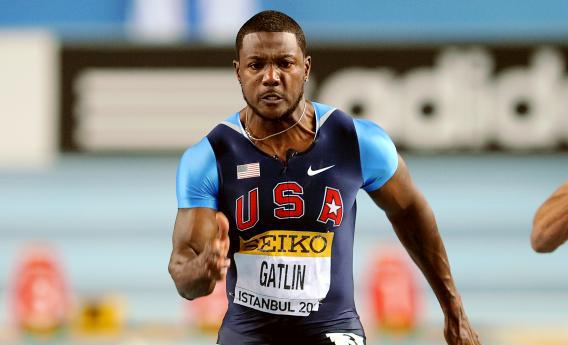American sprinter Justin Gatlin, who was suspended for four years beginning in 2006 for using anabolic steroids, won the 60 meters at the world indoor championships in Turkey earlier this month. The 30-year-old former Olympic champion is now hoping to compete in the London Olympic Games, and told NPR last week that he’s running as fast as ever. Can an athlete reap the benefits of steroids even after serving a four-year suspension?
It’s theoretically possible. Some substances, such as testosterone, last in the body for only a few days. Other drugs, such as nandrolone, can remain at low concentrations for weeks or months. At the end of that period, the direct, muscle-building benefits of the supplements end, and the body begins to return to its pre-doping baseline. But no one really knows how long that process takes. Some researchers believe a doper will cease to benefit from the substances within a year. Others think that performance-enhancing drugs alter gene expression for many years and therefore athletes who dope may be able to build muscle more easily than their clean opponents long after they stop using. But this theory is largely untested, and research isn’t forthcoming. Few organizations are interested in funding it, and hospital ethics boards wouldn’t allow doctors to prescribe large doses of anabolic steroids to patients for no clinical reason.
The theory that steroids might produce long-term effects is supported by observations of more-natural phenomena. Even the effects of a normal, unenhanced training regimen can linger in the body for years. Consider a hypothetical, non-doping power lifter who trains hard for several years, reaching a maximum squat of 500 pounds. Then he suffers an injury and can’t train for one year. At the end of that year, his max has dropped to 350 pounds. Once he starts training again, that lifter will get back to his 500-pound max more quickly, and with less intense training, than would a beginner who started from a 350-pound max at the same time. Researchers aren’t completely sure why this happens, but some believe that heavy, prolonged exercise causes epigenetic changes that make it more efficient to create the proteins that build muscle. While these changes aren’t permanent—a sedentary former athlete will eventually lose the benefits of his former workout regime—the effects of intense exercise seem to last for a long time. An athlete who used performance-enhancing drug might see this change extended or intensified, if only because he was able to train harder and for longer hours during the time he was juicing.
The duration of doping suspensions has no relationship to how long the benefits of the drugs are thought to last. No one can calculate that period with any certainty, and the indirect benefits may last throughout an athlete’s career. Suspensions for track and field athletes are usually based on an arbiter’s sense of justice. The United States Anti-Doping Agency recommended a four-year ban for Gatlin, disqualifying him from only the 2008 Beijing games, because of his cooperation in investigating other cases of doping in the sport.
It’s unlikely that Gatlin was targeting these long-term benefits. He was caught supplementing his testosterone supply, which eventually stops the body from manufacturing the hormone naturally. Abruptly ceasing the supplements after getting caught causes testosterone levels to drop way below normal, making it very difficult to participate in training for several months, until the body starts making the hormone again. Athletes also tend to feel awful during this testosterone hangover. It’s possible to wean yourself off large doses of supplemental testosterone slowly, but the process isn’t easily managed and some hormone swings are unavoidable.
Got a question about today’s news? Ask the Explainer.
Explainer thanks Keith Baar of UC Davis, Anthony Butch and Don Catlin of UCLA, and Gary Wadler of the World Anti-Doping Agency. Thanks also to Aaron Arnold for asking the question.
Video Explainer: Why Aren’t There More Slam Dunks in Women’s Basketball?
This video was produced from an original Explainer by Brian Palmer. Want more questions answered? You can now watch video Explainers at Slate’s News Channel on YouTube.
